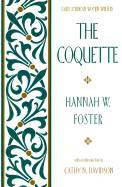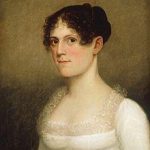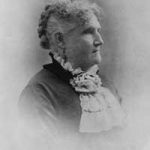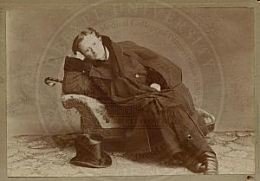Writer and Mother of Aaron Burr
From 1754 through 1757, Esther Edwards Burr – daughter of theologian Jonathan Edwards, wife of Aaron Burr, Sr. and mother of the infamous Aaron Burr – wrote a daily letter-journal to her friend Sarah Prince. Burr’s journal stands as an account of current events and of her daily activities and interactions with a wide circle of family, friends, acquaintances, and her husband’s students and colleagues.
Esther interprets her life through the primary cultural institution in her life, the Puritan evangelical church. Her religion shapes her sense of self; everything she is and does, everything that happens to her, she puts within the context of her faith and her God.
Esther Edwards was born on February 13, 1732, the third of the eleven children born to Congregational minister and theologian Jonathan Edwards and his wife, Sarah Pierpont Edwards. Descended from prominent Puritan divines and pious women on both sides of her family, Esther Edwards was early immersed in a world of spiritual striving and turmoil.
Born in Northampton, Massachusetts, she was named for her great-grandmother Esther Stoddard, who was a woman of great spiritual authority. Before her death in 1736, Esther Stoddard led women’s prayer groups and won a reputation for being even more forceful and learned than her distinguished husband.
Esther Edwards underwent conversion as a teenager, and in 1752 she followed the path of her great-grandmother and mother when she married a minister, Aaron Burr, pastor of the Presbyterian church at Newark, New Jersey, and later a founder and second president of Princeton College. He was sixteen years her senior, self-assured, and personally appealing.
Born into a wealthy Connecticut family with extensive land holdings, Aaron Burr experienced conversion to evangelicalism shortly after his graduation from Yale College in 1735. After he was licensed to preach in 1736, Burr served in several pulpits before accepting the call to Newark, New Jersey.
In 1754, Esther Burr began a journal of her daily life and exchanged it periodically with one kept by her friend, Sarah Prince of Boston. Her journal is valuable for the views it gives of a Puritan woman’s life in the mid-18th century and for the insights into how Puritan values and habits of mind helped a woman to understand and evaluate the world in which she lived.
The dominant themes in Esther’s journal are the loneliness and hardship of everyday existence which are only made endurable by the knowledge of God’s guidance of human affairs. When her second child was born, Esther was entirely alone, but her faith in God helped her to meet the ordeal:
I felt very gloomy when I found I was actually in labour to think that I was, as it were, destitute of earthly friends — no mother, no husband, and none of my particular friends that belong to the town… only my dear God was all of these relations to me.
On another occasion she was visiting her father in Stockbridge, Massachusetts, where the community was expecting an Indian attack. She had a momentary crisis of faith: “I want to be made willing to die in any way God pleases, but I am not willing to be butchered by a barbarous enemy nor can’t make myself willing.” Ultimately she trusted in Providence and prayed for survival: the Indians never attacked.
In the Puritan manner, the journal records events large and small — for God’s will was manifest in every activity of life. Thus the journal tells of visitations to the sick, attendance at sermons, entertainment of the governor’s wife with “cakes” on militia day, the depredations of the French and the Indians, the political maneuverings of the Newark community, and the problems of moving to Princeton and establishing the college — all given with frank, moral assessments of what Burr thinks of the behavior of her contemporaries.
Her commentary on the protestations of the local government as it prepared to meet the threatened advance of the French and the Indians is typical:
I am perplexed about our publick affairs, the Men say (tho not Mr. Burr, he is not of that sort) that women have no business to concern themselves about ’em but to trust to those that know better and be content to be destroyed — because they did all for the best — Indeed, if I was convinced that our great men did as they really thought was for the Glory of God and the good of the country, it would go a great ways to make me easy.
As a result of this personal evaluation of the events and interests of her time, Burr’s journal has a warm, emotional quality that makes the incidents of the past come alive. She is frank and explicit, never falsely sentimental or literary. Like the preachers she heard regularly, Esther kept to the plain style, proudly asserting that the “busy housewife” had no time to be “literary.” The journal is, then, a sensitive, lively account of God’s way with the Puritan woman. It is a moving story of a woman’s growth to maturity within the Puritan tradition of provincial America.
Esther Edwards Burr’s letter-journal provides one of the earliest extensive accounts of a colonial American woman’s daily life. Most women of her era wrote primarily for exchange with friends and circulation among acquaintances, and the letter-journal that Esther Burr exchanged with Sarah Prince was no exception.
Writing on vellum with quill pens, Esther Burr recorded daily entries of varied lengths, and then she bundled them into “paquets” of up to twenty pages whenever a suitable courier was available. These “paquets” also contained “privacies,” secret enclosures recording candid opinions on mutual acquaintances that Sarah burned after reading them.
Esther’s son Aaron Burr, Jr. was born on February 6, 1756, at Newark, New Jersey. Aaron Sr. was seized with a fever and passed away on September 24, 1757.
Esther Edwards Burr contracted smallpox and died in April 1758 at Princeton, New Jersey. Aaron Jr. and his sister Sarah were placed in the Elizabethtown home of Esther’s brother, the Reverend Timothy Edwards.
In her journal, Esther Burr chronicled daily life from 1754 to 1757, giving information on topics such as the founding of Princeton College, religious revivals, childbearing practices, the French and Indian War, and women’s roles during the period. It would be published in several editions by Jeremiah Eames Rankin as Esther Burr’s Journal.






